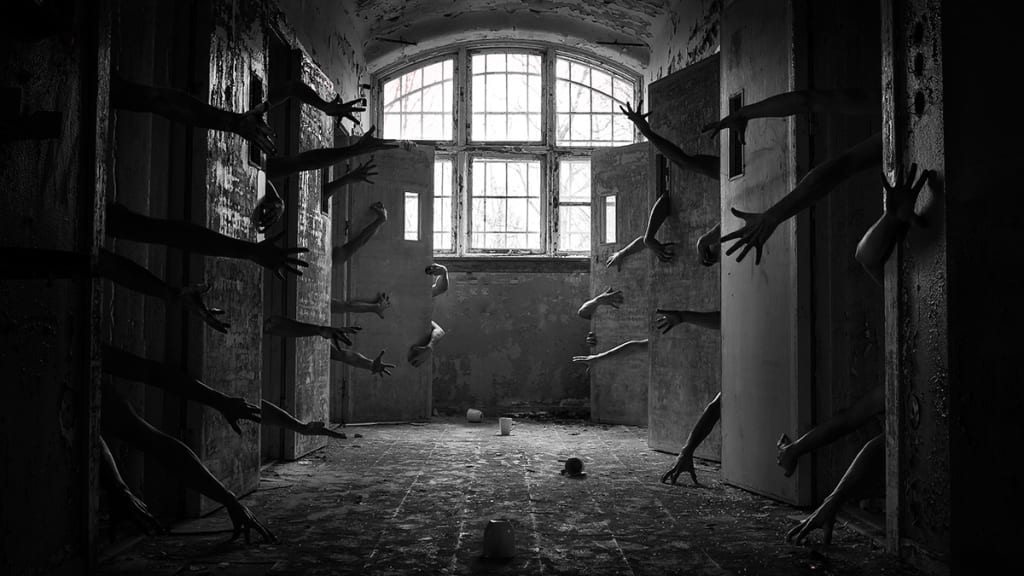Ten Horrific Mental Health Treatments Throughout History
We've come a long way... haven't we?

The taboo around mental illnesses is fracturing. People are encouraged to speak openly about their struggles without fear of the repercussions; the world’s stance on mental health is drastically changing.
There was a time when people suffered in silence. They did so for fear of the torturous ‘treatments’ that they would receive under ‘specialist’ hands. As there was not a concrete understanding of mental illnesses, this lack of understanding led to some horrific treatments that are no longer mainstream today.
Asylums
Most treatments took place in asylums. While having a place devoted to caring for the vulnerable seems like a good idea, the olden ideal was far more damaging. Having patients isolated from the outside world reinforced the helplessness of their own mental state. In addition, many of the patients admitted were the poor and the marginalised, who had no other family to take care of them. This lack of accountability allowed dark practises to go on within the confines of asylums.
The most notorious asylum was Bedlam Hospital, situated in London. Founded in the 13th century by the politician Simon Fitzmary, the institution started out as a charitable hospital. The hospital expanded, with the monks taking on patients who were suffering from ‘madness.’ The asylum was a mix between punishment and religious devotion. The shock of corporal punishment was believed to shock the subjects back into their right senses.
Experimentation
In the 20th century, people didn’t really understand mental illnesses or their causes. This led to scientists taking advantage of vulnerable patients in order to answer the unknown.
The most shocking experiments came from Dr. Henry Cotton, who ‘all but butchered his patients’ whilst trying to cure them. With the Germ Theory being prominent at the time, mental illnesses were linked with infections. Cotton began experimenting, removing the teeth of his patients in the hopes of curing them. When that failed, he removed organs and reproductive organs, all to no avail.
Soldiers who suffered with PTSD as a result of their experiences and were prisoners of war were experimented on by the Japanese in World War II. In Unit 731, vivisections on live patients were performed. They were gassed until their eyes popped out, and taken out in the cold to freeze to death.
Restraints
The use of restraints for people diagnosed with a mental illness is truly chilling. Mainstream restraints were common, such as chains, shackles, and vices, which all restricted the movement of the patient. Some were done for the wellbeing of the subject, who may have posed as a threat not only to staff and other patients, but to themselves. However, the idea of being physically restrained when you are so mentally fragile is almost unbearable to think about.
One form of restraint, the Coercion Chair (or the English Chair), was ultimately turned into a wooden coffin once a patient was seated. When the patient was seated, a hinged door at the base was closed in front of the feet. A lid was shut over the thighs, and a board fitted into groves was placed down, so that only the head of the patient was visible. Another block of wood with a small door that could be opened to feed the patient was fitted over the head.
Insulin-Coma Therapy
Insulin-Coma Therapy (ICT) came to the U.S. from central Europe at the end of the 1930s. Before the discovery of tranquilising drugs, insulin-coma therapy was often used as an alternative solution to treating mental illnesses, such as schizophrenia.
This form of treatment included giving the patient large dosages of insulin, which reduced the level of sugar in the blood, inducing a coma. The patient was kept in a coma-like state for an hour or so, until the doctors terminated it by adding a solution of warm saltwater through a stomach tube, or injecting glucose into their bloodstream.
Insulin coma therapy was proved to be effective for people who had not been suffering with their illnesses for over two years, with the rate of recovery from schizophrenia being the highest within the first two years of the patient being ill. The ICT mortality rate varied from 1% to 10% of patients treated. Prolonged comas, in which the patient did not respond to the administration of glucose, was a constant threat. However, at the time, ICT and ECT were the only treatments that offered the possibility of successful resolution.
Pyrotherapy
Attributed to Dr Wagner-Jauregg after World War 1, pyrotherapy was introduced as a product of intense observations of a patient. Jauregg practiced his theories on patients known as the “general paresis of the insane,” or GPI. GPI was caused by the advanced stages of syphilis, in which the disease would burrow into the brain and produce symptoms of schizophrenia or bipolar disorder.
Jauregg’s patient, Hilda, had been lost to the turbulent madness of the disease for more than a year when she came down with a fever entirely unrelated to her syphilis, a symptom of a respiratory infection. When the fever subsided, Hilda awoke clear-headed and lucid. Her psychosis had vanished.
Jauregg theorised that, by infecting subjects with diseases and then curing them, he could rid them of the infections on the brain. He used malaria, as there was a steady flow of malaria-infected blood from soldiers returning from World War 1. After infecting patients, they succumbed to the characteristic fever. Shortly afterwards they exhibited dramatic improvements in their mental state. Soon, pyrotherapy was being used in asylums across the country. Though the fever cure mitigated the psychotic symptoms of GPI, it was futile against all other forms of mental illness. Since disorders were not caused by pathogens, there was nothing for the fever to kill, except the patient. About 15% of patients treated with Wagner-Jauregg’s cure died from the procedure.
Moral Therapy
Moral Therapy was one of the most humane treatments that originated in the late 1700s and early 1800s, founded by the Quaker asylum director William Tuke. He became intrigued by the practice of the humane care of the mentally ill when a member of The Society of Friends (Quakers) in York, England, was committed to the York Asylum. When members of The Friends attempted to visit her, they were denied permission, and shortly after the woman died of neglect or mistreatment.
Tuke saw the need for change, and presented his ideas to The Society of Friends members, and together they formulated the idea of establishing a retreat in York, designed to house 33 patients. This number doubled after Tuke visited St. Luke’s Hospital, where he saw the neglect and disregard for patients.
Tuke’s idea was to make the asylum a strict, well-run household. Patients dined together, made polite conversation at the table and considered the consequences of their actions. The asylum consisted of comprehensive rules and constant surveillance, enforced by simple rewards and punishments.
However, critics in the early 1900s argued moral therapy did not cure patients. They said it made patients dependent on the doctor and the asylum, living in a constructed fantasy. Later in the 1900s, historians argued moral treatment replaced the actual chains of early asylums with invisible chains, making them even harder to escape from.
Rotation Therapy
Rotation Therapy was inspired by the grandfather of Charles Darwin, Erasmus, with there being two ways of performing the treatment. Both contained the same concept: a chair or bed being suspended and spun. The methods obtained the same results, having the patients spun on the apparatus until they promised to comply with the doctors and get better. After they gave their word, they could go and sleep and recover.
However, after the nausea had worn off, the patients were still ill. They were forced to repeat the process again and again, winding up in a vicious cycle. The side effects of being suspended in the air and spun around were like those of the illnesses they were trying to treat, such as nausea, bowel movements, vertigo, dizziness, and vomiting. Further results were tiredness and a deep sleep, which often lasted for many hours. Doctors at the time believed in its success, with Dr Joseph Mason Cox stating that he knew someone that owed his life to the swing.
Exorcisms
The connection between demonic possession and mental illnesses was based on similar symptoms, with illnesses of the mind being assumed to be caused by demons. The resulting treatment approved by religious officials was often an exorcism.
One of the most famous cases of an exorcism being performed on someone was mentally ill was that of Anneliese Michel, who began experiencing strange happenings at the age of 16. She was subjected to convulsions, and later began seeing things whilst at her prayers. The medication she was given failed to work. She was taken to priests until one of them suggested an exorcism.
Anneliese Michel said that Judas, Nero, Hitler, Cain, Lucifer, and others were inside of her. Over a period of ten months, Father Arnold Renz and Pastor Ernst Alt performed 67 exorcisms on the tormented soul. She allegedly urinated and defecated on the floor frequently, also licking up her own urine. She ate insects, growled at religious icons, and sat under her kitchen table barking for two days. Anneliese Michel died of dehydration and malnutrition on July 1, 1976. The 23-year-old woman weighed 68 pounds at the time of her death. Her parents, Josef and Anna Michel, alongside the two exorcists, were eventually charged with negligent homicide.
Regardless of what ailment Anneliese suffered with, the constant ritual of undergoing an exorcism bought into her own ideas as to what was causing the decline in her mental state. The use of exorcisms to try and cure her proved futile, and she died as a result.
Trephination
Trephination is one of the earliest forms of surgery that archaeologists have discovered in the form of cave paintings and human remains, hailing from the Neolithic period. It consisted of having a hole drilled into your skull, with a section being scraped away. The practice was commonly used in Ancient Egypt, with the scrapings of the skull being used to make potions.
Trephination was used to allow demons to exit the brain, which were believed to be causing mental illnesses. It was a cleansing ritual, with the brain itself being left alone, unlike in a lobotomy, where parts are removed. It also was thought to relieve pressure in the brain, and cure seizures, which could be attributed to demonic possession. It was used in the Medieval period, and was relatively successful in terms of the number of survivors.
Sex
Yes, you read that right. Significant ancients like Plato, Aristotle, and Hippocrates, all agreed that hysteria in women came from a lack of sex and a wandering womb. If a womb was not used for its purpose of having children, then it was believed to wander, causing an episode of hysterical madness that was solely attributed to women. The cure for hysteria was to have a child, having the womb fulfil its purpose, with the Greek word for hysteria hailing from the word for uterus.
Hippocrates went on to claim that a woman needed sexual satisfaction to keep her womb regulating normally. He believed that the uterus was cold and wet, prone to becoming sick. When deprived of sexual benefits, which widened a woman’s canals and promoted the cleansing of the body, toxic fumes were produced. These then poisoned the rest of the female body, being common in virgins and widows. It caused various kinds of disorders such as anxiety, tremors, convulsions and paralysis. Ah, misogyny at its finest.
About the Creator
Charlotte Williams
Instagram: @charmwillwrites
Creative Writing Grad from the UK.
Interested in myths, and true crime.






Comments
There are no comments for this story
Be the first to respond and start the conversation.